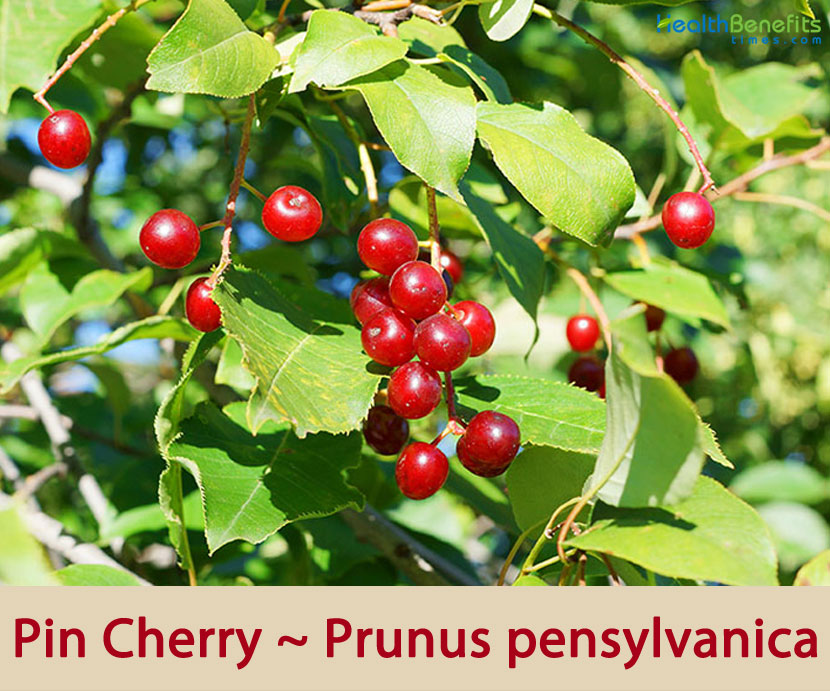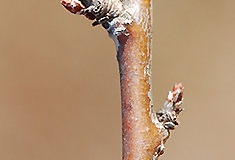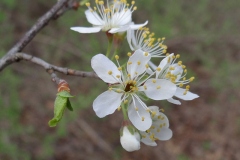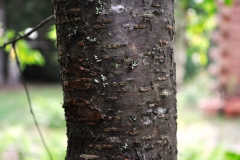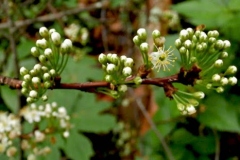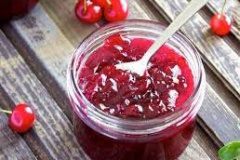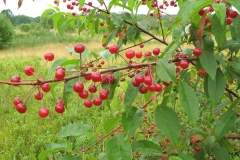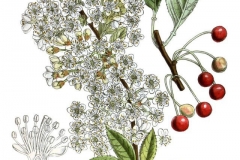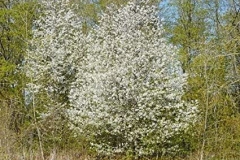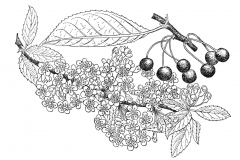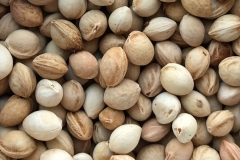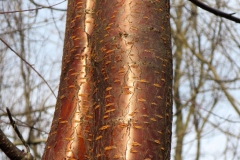| Pin Cherry Quick Facts | |
|---|---|
| Name: | Pin Cherry |
| Scientific Name: | Prunus pensylvanica |
| Origin | Canada from Newfoundland and southern Labrador to British Columbia and the southern Northwest Territories |
| Colors | Green at first, turning bright red as they mature |
| Shapes | Fleshy, one-seeded, spherical or ellipse-shaped drupes that are about 0.15 to 0.3 inch (4-8 mm) across |
| Taste | Sour |
| Health benefits | Beneficial for fevers, bronchitis, coughs and colds, infections, blood poisoning, laryngitis, sore eyes, ulcers and gastrointestinal issues |
| Name | Pin Cherry |
|---|---|
| Scientific Name | Prunus pensylvanica |
| Native | Canada from Newfoundland and southern Labrador to British Columbia and the southern Northwest Territories. Additionally it is very common in New England and the Great Lakes region. It can also be found in the Appalachian Mountains as far south as northern Georgia and eastern Tennessee |
| Common Names | Pin cherry, Bird cherry, Fire cherry, Red cherry, Wild red cherry, Northern pin cherry, pigeon cherry |
| Name in Other Languages | Afrikaans: Pin kersie Albanian: Pin qershi Amharic: Pin cherry Arabic: Dubus alkurz (دبوس الكرز) Armenian: K’vorots’ bal (քորոց բալ) Azerbaijani: Pin albalı Bengali: Pina cēri (পিন চেরি) Bulgarian: Shtipka cheresha (щипка череша) Burmese: Hkyaalre pain (ချယ်ရီပင်) Chinese: Zhēn yīngtáo (针樱桃), Bīn zhōu yīngtáo (宾州樱桃) Cree: Nipinimina Croatian: Pin trešnja Czech: Třešeň Danish: Pin kirsebær Dutch: Pin kers English: Pin cherry, Bird cherry, Fire cherry, Red cherry, Wild red cherry, Northern pin cherry, pigeon cherry Esperanto: Pinglo ĉerizo Estonian: Pin kirss Filipino: Pin cherry Finnish: Pin kirsikka French: Broche cerise, Cerisier de Pennsylvanie, Arbre à petites merises, Cerisier d’été, Cerisier petit-merisier, Petit merisier, prunier de Pennsylvanie, petit merisier Georgian: Alubali (ალუბალი) German: Nadel Kirsche, Feuerkirsche, Feuerkirschbaum, pennsylvanische Kirsche Greek: Kerási (κεράσι) Gujarati: Pina cērī (પિન ચેરી) Hausa: Fil ceri Hebrew: סיכה דובדבן Hindi: Pin cheree (पिन चेरी) Hungarian: Pin cseresznye Icelandic: Pinnar kirsuber Indonesian: Pin cherry Irish: Bioráin silíní Italian: Pin cherry, ciliegio tardive, pruno della Pensilvania Japanese: Pincherī (ピンチェリー) Javanese: Pin Cherry Kannada: Pin cerri (ಪಿನ್ ಚೆರ್ರಿ) Kazakh: Tüyir şïe (түйір шие) Korean: Pin chili (핀 체리) Kurdish: Serma çinîn Lao: Mak kheu (ໝາກ ເຂືອ) Latin: Pin cerasus Latvian: Kiršu pin Lithuanian: Pin vyšnia Macedonian: Pina creša (пина цреша) Malagasy: Pin serry Malay: Ceri pin Malayalam: Pin ceṟi (പിൻ ചെറി) Maltese: Pin taċ-ċirasa Marathi: Pin cheree (पिन चेरी) Mikmaq: Maskwe’smanaqsi Mongolian: Züü intoor (зүү интоор) Nepali: Pin cheree (पिन चेरी) Norwegian: Pin kirsebær Oriya: ପିନ୍ ଚେରି Pashto: پن چیری Persian: گیلاس Polish: Szpilka wiśnia Portuguese: Pin cereja Punjabi: Pina cairī (ਪਿੰਨ ਚੈਰੀ) Romanian: Cireș de cep Russian: Vishnya (вишня), çeryomuha pensilvanskaya (черёмуха пенсильванская) Serbian: Pin cherri (пин цхерри) Sindhi: پن چيري Sinhala: Pin ceri (පින් චෙරි) Slovenian: Pin češnja Spanish: Pin cherry Sudanese: Pin céri Swedish: Pin cherry, Amerikanskt häggkörsbär, Amerikansk körsbärshägg Tajik: Gelos (гелос ) Tamil: Muḷ cerri (முள் செர்ரி) Telugu: Pin cerrī (పిన్ చెర్రీ) Thai: Chex r̒ rī̀ phin (เชอร์รี่พิน) Turkish: Pin kiraz Ukrainian: Shpil ka vishnya (шпилька вишня) Urdu: پن چیری Uzbek: Igna gilos Vietnamese: Pin anh đào Welsh: Pin ceirios, Coed Ceirios Pensylfania, Coeden Geirios Pensylfaniaa Zulu: I-pin cherry |
| Plant Growth Habit | Small, fast-growing, short-lived, unarmed, deciduous shrub or small tree |
| Growing Climates | Rocky woods in moist rather rich soils, wet woodlands, old tamarack bogs, inter dunal swamps, open forest, plains, valleys to lower subalpine, thickets along streams and lakeshores, in clearings, roadsides, burned-over areas, disturbed sites, rocky hillsides and cliffs |
| Soil | Grows on infertile rocky ledges, sandy plains, moist loamy soils, and rich loams |
| Plant Size | 15 to 50 feet (5-15 m) tall and have a trunk diameter of about 4 to 20 inches (10-51 cm) |
| Root | Shallow, lateral, spreading root system. Most roots are within 24 inches of the soil surface |
| Bark | Bark on young trees is thin, smooth, shiny, and dark reddish-brown with numerous conspicuous, long, horizontal, pore-like openings (lenticels). On mature trees the bark is rough and sometimes peels in horizontal strips |
| Twigs | Slender, hairless, shiny, and red or reddish-brown, with tiny, orange, dot-like lenticels. They are covered with a grayish skin at first but that quickly wears off |
| Buds | Lateral buds are small, 1 ⁄16 inches to ⅛ inches long, rounded, and reddish-brown |
| Wood | Coarse-grained, soft and light |
| Leaf | Lance-shaped, 1¾ — 4¾ inches long, and ⅝ – 2 inches wide, 2 to 3 times longer than wide. They are broadly angled or rounded at the base and taper to a long point at the tip with concave sides along the tip |
| Flowering season | April to May |
| Flower | ½ inches in diameter. There are 5 sepals, 5 petals, 10 to 30 stamens, and 1 style. The sepals are green, 1 ⁄32 – ⅛ inches long, untoothed, hairless, and bent backward. The petals are white, ⅛ – ¼ inches long and conspicuously narrowed at the base (clawed) |
| Fruit Shape & Size | Fleshy, one-seeded, spherical or ellipse-shaped drupes that are about 0.15 to 0.3 inch (4-8 mm) across |
| Fruit Color | Green at first, turning bright red as they mature |
| Seed | 0.15 to 0.24 inch (4-6 mm) in diameter with a thick seed coat. There are 13,600 to 22,700 seeds per pound |
| Propagation | By seed and Sprouts |
| Taste | Sour |
| Lifespan | Only 20 to 40 years |
| Season | July- August |
| Precautions |
|
Plant Description
Pin Cherry is a small, fast-growing, short-lived, unarmed, deciduous shrub or small tree that normally grows about 15 to 50 feet (5-15 m) tall and has a trunk diameter of about 4 to 20 inches (10-51 cm). However, trees up to 100 feet tall (30 m) have been found in the southern Appalachians, with the largest size attained on western slopes of the Great Smoky Mountains. In western North America, pin cherry may be generally smaller with an arching shrub form, growing 5 to 15 feet (1.5-4.5 m) tall and spreading 5 to 10 feet. The tree generally has a straight trunk and a narrow, round-topped crown, though it may form thickets. Branches, at first ascending, become more or less horizontal and spreading with age. The plant is found growing in rocky woods in moist rather rich soils, wet woodlands, old tamarack bogs, inter dunal swamps, open forest, plains, valleys to lower subalpine, thickets along streams and lakeshores, in clearings, roadsides, burned-over areas, disturbed sites, rocky hillsides and cliffs. It grows on infertile rocky ledges, sandy plains, moist loamy soils, and rich loams.
Trunk
The trunk is fairly straight and sometimes leaning. The crown is narrow and rounded at the top. The branches on young trees are ascending. As the tree ages, the branches become nearly horizontal.
Bark
The bark on young trees is thin, smooth, shiny, and dark reddish-brown with numerous conspicuous, long, horizontal, pore-like openings (lenticels). The lenticels are widely-spaced, raised, warty, and orange. As the tree ages the bark turns gray. On mature trees the bark is rough and sometimes peels in horizontal strips, and the lenticels are rougher and darker. The inner bark is slightly aromatic and very bitter. The large lenticels show orange when rubbed.
Twigs
The twigs are very slender, hairless, shiny, and red or reddish-brown, with tiny, orange, dot-like lenticels. They are covered with a grayish skin at first but that quickly wears off. They have brown pith and a disagreeable bitter almond taste. The leaf scars are half-round to elliptical. They have 3 bundle scars.
Buds
Lateral buds are small, 1 ⁄16 inches to ⅛ inches long, rounded, and reddish-brown. They diverge slightly from the twig. The terminal bud is similar and appears with a cluster of two or more lateral buds at the end of the twig.
Wood
The wood is coarse-grained, soft and light. It is not used commercially. The gum is edible.
Leaves
Leaves are deciduous, alternate, and clustered at the ends of the twigs. They are on ⅜ -¾ inches long, hairless leaf stalks (petioles). The petioles often have one to three, more often two, small, red, wart-like swellings (glands) near the tip where the petiole meets the blade. The leaf blades are lance-shaped, 1¾ — 4¾ inches long, and ⅝ – 2 inches wide, 2 to 3 times longer than wide. They are broadly angled or rounded at the base and taper to a long point at the tip with concave sides along the tip. The upper surface is shiny, hairless and dark yellowish-green. The lower surface is paler and usually hairless, sometimes hairy along the main veins at first, becoming hairless. The margins are finely and irregularly toothed all the way to the base with sharp or rounded, forward pointing teeth. There is a small red or yellow gland at the tip of each tooth near the sinus. In autumn the leaves turn yellow.
Flower
Inflorescence is 2 to 5, sometimes 6 or 7, flowers in a stalk less umbrella-shaped (umbel-like) or flat-topped cluster (corymb) at the end of a short, 1 ⁄32 – 5 ⁄16 inches long, branch-like base (fascicle). The clusters appear at the ends of current year twigs and at the axils of previous year branchlets. Each flower is on a hairless, ⅜ -¾ inches long flower stalk (pedicel). Each pedicel is subtended by a minute, modified leaves (bracts). The flowers open in early May to mid-June when the leaves are about half size.
Each flower is about ½ inches in diameter. There are 5 sepals, 5 petals, 10 to 30 stamens, and 1 style. The sepals are green, 1 ⁄32 – ⅛ inches long, untoothed, hairless, and bent backward. The petals are white, ⅛ – ¼ inches long and conspicuously narrowed at the base (clawed). The claw is about 1 ⁄32 inches long. The expanded portion of the petal is elliptic, inversely egg-shaped, or almost circular. The stamens have white filaments and yellow anthers.
Fruit
Fertile flowers are followed by fleshy, one-seeded, spherical or ellipse-shaped drupes that are about ¼ – ⅜ inches in diameter. It is green at first, turning bright red, shiny, and very sour when it matures in early July to late Mid-August. They are arranged in groups of 2 to 6. The seed is not flattened. Seeds are 0.15 to 0.24 inch (4-6 mm) in diameter with a thick seed coat. There are 13,600 to 22,700 seeds per pound.
Traditional uses and benefits of Pin Cherry
- An infusion of the bark has been used in the treatment of fevers, bronchitis, coughs and colds, infections and blood poisoning.
- A decoction of the inner bark has been used in the treatment of laryngitis.
- A poultice of the boiled, shredded inner bark has been applied to a bleeding umbilical cord.
- An infusion of the inner bark has been used as an eye wash for sore eyes.
- The astringent root bark has been used as a wash on old sores and ulcers.
- A decoction of the root has been used as a treatment for stomach pains.
- The fruit is often used domestically in the preparation of cough mixtures.
- In small amounts this exceedingly poisonous compound stimulates respiration, improves digestion and gives a sense of well-being.
- An infusion of the bark was used for cough medicines by the Algonquin, Cherokee, Iroquois, Ojibwa, Potawatomi, and Wet’suwet’en (Moerman).
- Bark infusion was also used to treat blood poisoning, to treat sore eyes, and stomach pains.
- It is used as a burn salve and measles.
- The Cherokee used the pin cherry fruit to treat gastrointestinal issues.
Culinary Uses
- It is usually too sour to be eaten raw; it is used mainly for making pies, jellies, jams and preserves.
- Gum that exudes from the trunk can be used as a chewing gum.
- Seed can be consumed raw or cooked.
- Do not eat the seed if it is too bitter.
- A jelly or syrup can be made from the drupes by boiling them down in water, straining out the stones and adding sugar to taste.
- The Iroquois used the cherries in small cakes and breads, while the dried fruits were taken as hunting food.
- For the Ojibwa, pin cherries were an especially abundant food and besides eating them fresh, they were also dried and sometimes ground into flour for soups.
Other Facts
- Green dye can be obtained from the leaves.
- Dark grey to green dye can be obtained from the fruit.
- The outer bark is used to ornament baskets.
- It is watertight and resists decay.
- The tree has a vigorous root system and is sometimes planted to stabilize soils and contain erosion.
- It is a good pioneer species for burnt over land.
- It establishes quickly, providing shelter for other woodland trees and then dying out.
- Wood is only used as a fuel.
- Pin cherry is not used for lumber and is considered a noncommercial species.
- Bark was also used in basketry, especially by British Columbians, who would soak it in a red or black color.
- The plant has been used as a rootstock for the sour cherry.
- Wood can be harvested as a source of biomass for fiber (presumably for paper pulp etc.)
References:
https://www.itis.gov/servlet/SingleRpt/SingleRpt?search_topic=TSN&search_value=24799#null
https://npgsweb.ars-grin.gov/gringlobal/taxon/taxonomydetail?id=30064
https://pfaf.org/user/Plant.aspx?LatinName=Prunus+pensylvanica
https://plants.usda.gov/home/plantProfile?symbol=PRPE2&photoID=prpe2_001_avd.tif
https://www.cabi.org/isc/datasheet/44342
http://www.theplantlist.org/tpl1.1/record/rjp-1021
https://www.fs.fed.us/database/feis/plants/tree/prupen/all.html
https://en.wikipedia.org/wiki/Prunus_pensylvanica
https://gd.eppo.int/taxon/PRNPE


